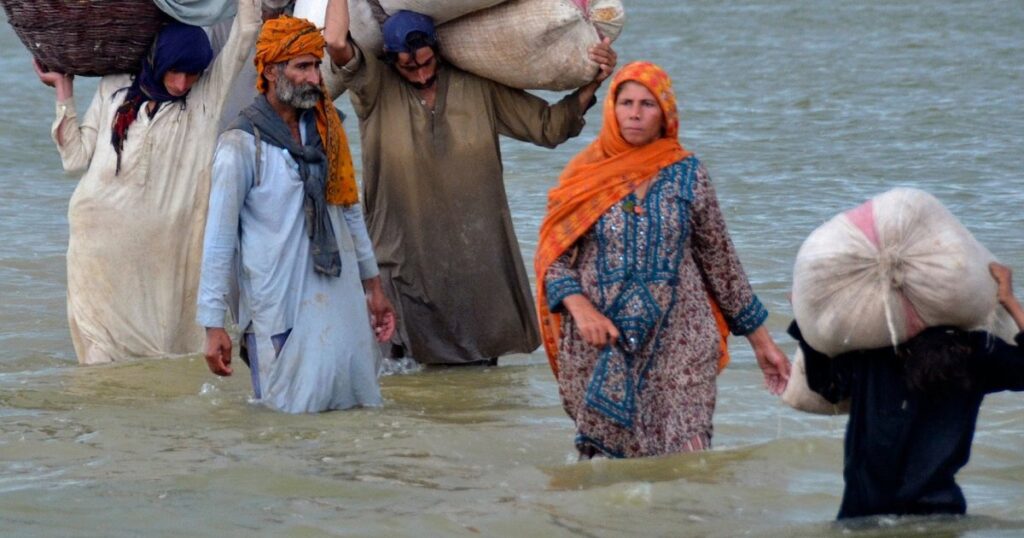Pakistan’s devastating floods have so far, killed over 1200 people, mostly children, since 14 June 22, displaced around 33 million and eroded livelihoods with the loss of an estimated one million livestock. In addition, floods washed away at least a million houses and damaged around 2 million acres of crops or 45% of agricultural land in Sindh, South Punjab and Baluchistan, signalling an impending food shortage. The unprecedented floods have caused a huge loss to the economy approximately US$10 billion [1] as per initial estimates. Overall, a third of Pakistan or an area roughly the size of the UK is inundated. Yet the country’s external debts and payments make it almost impossible for the government to focus on relief and rehabilitation of its people affected by the devastating floods. After the last mega-floods of 2010, the country is once again tottering from the devastation on an unimaginable scale.
Pertinent to mention Pakistan is one of the 52 countries facing a severe debt crisis [2]. The most critical problem faced by the country’s economy is repayment and servicing of its external debt, around $38 billion to the IMF, World Bank and other financial institutions, including loans from Chinese banks by the end of the current financial year.
The International Monetary Fund (IMF) has projected Pakistan’s external debt to reach $138.568 billion in 2022-23 up from $129.574 billion in 2021-22 [3]. The country had to pay $15.071 billion as external debt servicing in FY22, compared to $13.424 billion in the previous fiscal year. The breakdown shows that $12.093 billion were paid in principal payments and $2.978 billion in interest payments. Moreover, Pakistan has already paid around $ 65 million in IMF surcharges from 2018 to 2020 and it is likely to pay $ 392 million further from 2021 to 2030 in addition to its ballooning debt payments. Creditors claiming debt service of $38 billion this year put millions of lives at stake.
Constrained by limited options, Pakistan is weighing the option to seek an emergency loan once again from the IMF, as preliminary estimates suggest that devastating floods might have caused nearly $10 billion in losses and the economic growth rate could slow down to just 2% in the current fiscal year [4]. Equally important is to mention in April 2020, the IMF had approved $1.4 billion in emergency financing for Pakistan under the Rapid Financing Instrument (RFI) to help the country deal with the aftermath of the Covid-19 pandemic.
While emergency aid is essential in the situation, the point is what is at stake in Pakistan. Last month on August 22, the cash-strapped country was compelled to accept the IMF agreement to revive a bailout loan under the Extended Fund Facility (EFF) Program worth $ 4.2 billion [5] loaded with very strict conditions of a huge increase in oil, gas, electricity prices and drastic cuts in social expenditures etc., crushing the working-class millions. Not to forget in the next 12 months Pakistan needs at least $41 billion to repay a debt when inflation in Pakistan is growing at 26%, the second-highest rate in Asia.
Though the most recent flooding is different in nature compared to the one in 2010-the latter was a flash flood while the current is a riverine flood — in both cases, it can be argued that the damage caused by both disasters is the outcome of climate change as well as ill-advised development policies across Pakistan. Over the past 17 years, Pakistan has witnessed three major crises — before the current one. While the nature and scale of these crises were different, two of them were caused by natural hazards — the 2005 earthquake, which impacted 3.5 million people and the 2010 floods which affected more than 20 million people.
Another vital aspect of this ongoing catastrophe is the horrific impact of climate change on Pakistan. It produces less than 1% of global carbon emissions and yet it is one of the countries that bear the worst consequences of the climate crisis. For the past 20 years, it has consistently ranked in the Global Climate Risk Index as among the top ten most vulnerable countries. The climate catastrophe affecting millions of people in Pakistan is yet to get worse. Today its floods are brought by torrential rains 400-500 per cent more than normal and melting glaciers, in the future, it will be water scarcity posing a greater risk to the survival of millions of people.
The multiple crises of COVID, its economic impacts, exacerbating pre-pandemic hardships and the escalating climate-induced catastrophe are already more than enough reasons for the cancellation of the debts of Pakistan. The devastating floods in the country have rendered it even more urgent. It would be utterly inhumane for lenders – public and private – to fail to respond to this demand.
In such circumstances, an immediate outright cancellation of the debt is a minimum demand since Pakistan is no longer in a position to repay its loans and these floods have worsened the condition of the country’s economy. In the prevailing context, taking into account the UN rule of “state of necessity”, Pakistan must be allowed to utilize the available funds to meet the vital needs of 33 million flood affectees and not to repay its debt, without being sued for defaulting on its commitments.
Last but not the least, wealthy nations must meet their fair share of global climate actions, to stop catastrophic climate change of which Pakistan is the worst victim. It is high time to remind them of their obligations to deliver Climate Finance – to address loss and damage such as what the people of Pakistan are now experiencing.
Footnotes
[1] https://epaper.dawn.com/DetailImage.php?StoryImage=02_09_2022_001_006
[2] https://www.cadtm.org/Pakistan-in-a-perfect-debt-spiral-with-the-worst-impacts-of-the-pandemic
[3] https://www.brecorder.com/news/40152434/imf-says-pakistans-external-debt-to-reach-138568bn-in-2022-23
[4] https://tribune.com.pk/story/2374179/govt-mulls-taking-another-imf-loan-for-floods?fbclid=IwAR0Lu6b4MzQnm5vbdOb55M3OiIBry-yrnSirEhwuBQUg2e_swgTr2xc0AXk
[5] https://www.voanews.com/a/cash-strapped-pakistan-reaches-agreement-with-imf-to-revive-bailout-loan/6658983.html
[Abdul Khaliq is with CADTM Pakistan. Courtesy: The Committee for the Abolition of Illegitimate Debt (CADTM), an international network of activists founded on 15 March 1990 in Belgium that campaigns for the cancellation of debts in developing countries and for “the creation of a world respectful of people’s fundamental rights, needs and liberties”.]




